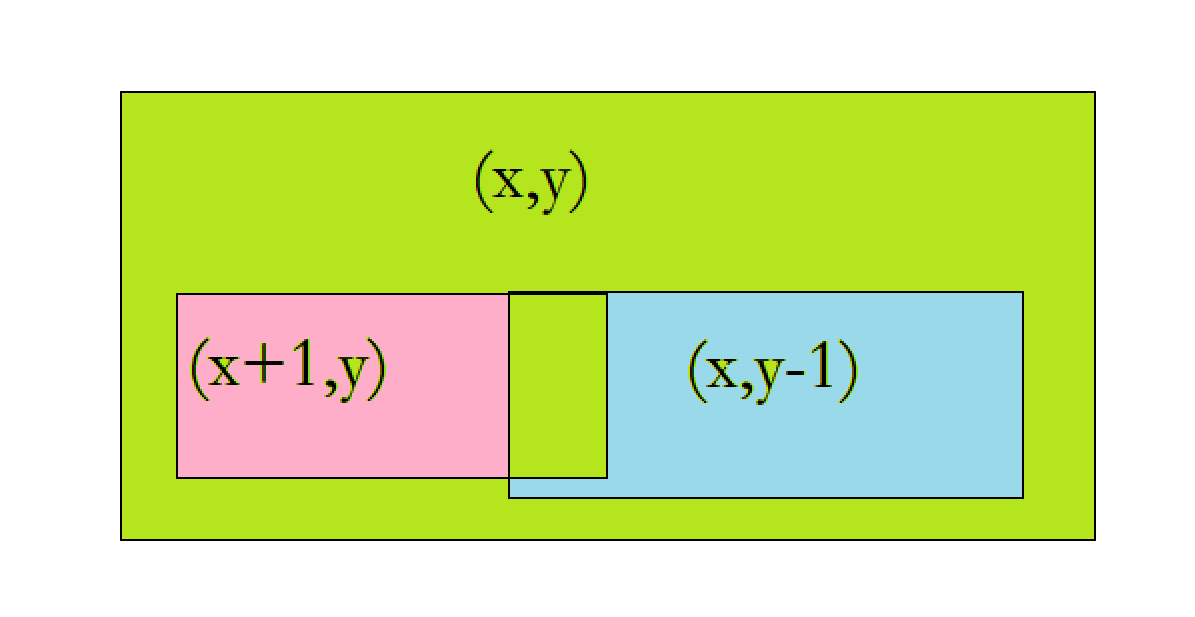E - Max Min AtCoder Beginner Contest 247
max min
We have a number sequence \(A = (A_1, A_2, \dots, A_N)\) of length \(N\) and integers \(X\) and \(Y\). Find the number of pairs of integers \((L, R)\) satisfying all the conditions below.
给定数列\(A = (A_1, A_2, \dots, A_N)\),求有多少数对 \((L, R)\) 满足以下条件
- \(1 \leq L \leq R \leq N\)
- The maximum value of \(A_L, A_{L+1}, \dots, A_R\) is \(X\), and the minimum is \(Y\).(\(A_L, A_{L+1}, \dots, A_R\)中最大的是\(X\),最小的是\(Y\)。)
Constraints
\(1≤N≤2×10^5\)
\(1 \leq A_i \leq 2 \times 10^5\)
\(1 \leq Y \leq X \leq 2 \times 10^5\)
All values in input are integers.
输入
N X Y
A1 A2 …… AN
输出
输出答案
题目解析
容斥原理
假设函数\(f(x,y)\)为所有值都在\((x,y)\)之内的区间的对数,那么我们可以通过容斥原理,得到上限为\(Y\),下界为\(X\)的答案数量。
由于\((x,y)\)是个很大的范围,势必包括了不以\(Y\)为最大值,不以\(X\)为最小值的区间,因此我们需要减去这些区间。
显而易见,区间\((x+1,y)\)的下限一定不是\(X\),区间\((x,y-1)\)的上限是\(y-1\),一定不是\(Y\),所有需要减去这两个区间。

值得注意的是,减去这两个区间后,又多剪了一个区间\((x+1,y-1)\),最终需要再加上,因此,最后的答案为:
函数\(f\)
我们可以选用双指针去得到在\((x,y)\)之间的所有数量,右指针\(r\)一直向后移动,直到遇到某数字在\((x,y)\)之外,这时左指针再放到右指针后面。
每次移动右指针,其答案数量都可以看作以\(r\)为右边界,从\(l\)到\(r\)的任意一个数字为左边界,答案变化为\(r-l+1\)。
AC CODE
#include<bits/stdc++.h>
using namespace std;
typedef long long ll;
const int N = 2e5+7;
ll a[N];
int n;
ll work(ll y, ll x) {
ll ans = 0;
for(int i = 1, j = 1 ; i <= n ; i++) {
if(a[i] < y || a[i] > x)
j = i+1;
ans += i-j+1;
}
return ans;
}
int main() {
int x,y;
cin >> n;
cin >> x >> y;
for(int i = 1 ; i <= n ; i++)
scanf("%lld",&a[i]);
ll all = work(y,x),t1 = work(y+1,x),t2 = work(y,x-1), t3 = work(y+1,x-1);
cout << all-t1-t2+t3;
}


 浙公网安备 33010602011771号
浙公网安备 33010602011771号